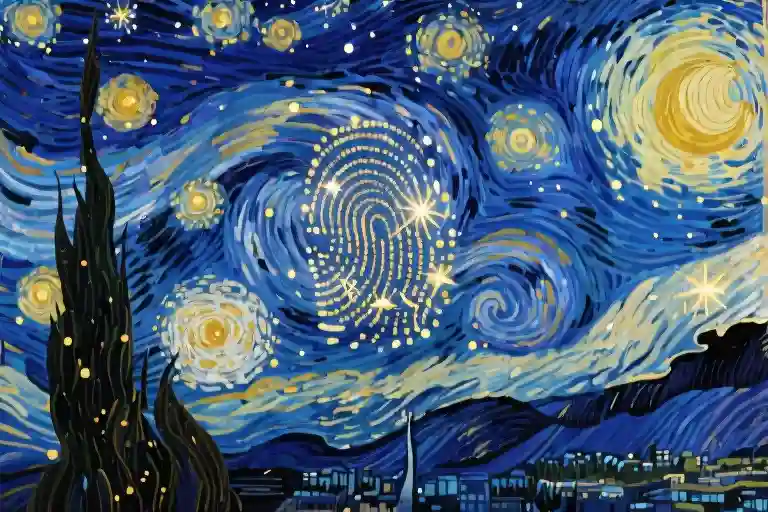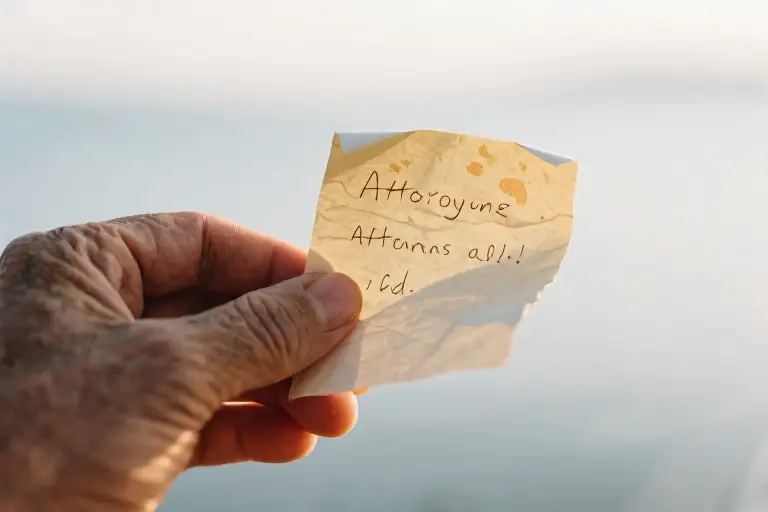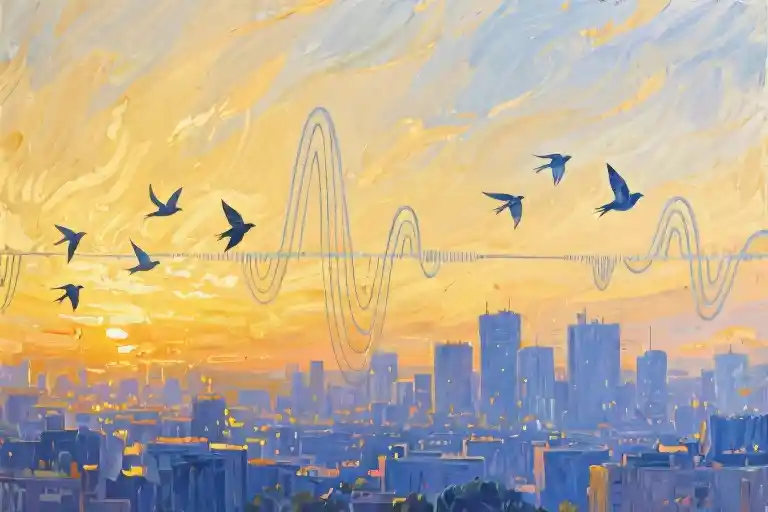The night air was cool against my skin as I tilted my head back, my gaze lost in the infinite tapestry above. There, among countless pinpricks of light, one star held my attention—its glow faint but persistent. What struck me most wasn’t its brilliance, but the cosmic irony: this light had traveled through space for millennia, yet the star itself had likely died ages ago. We were witnessing a ghost.
Isn’t that how most beautiful things work? The afterglow lingers long after the source is gone. That concert echo in your ears days later. The warmth of a hug imprinted on your skin. The way love leaves its fingerprints on your ribcage even when the person has walked away. We’re always left with the light of things that no longer exist in their original form.
Which makes me wonder—if endings are inevitable, why does my throat still tighten at the thought? Why do we build sandcastles knowing the tide will come? Why plant gardens we won’t see bloom? There’s something profoundly human about this contradiction: we who can calculate probabilities and predict outcomes still choose to invest in what we know won’t last.
Maybe that’s the secret no one mentions in those motivational quotes about seizing the day. It’s not about ignoring the inevitable, but rather embracing the temporary magic of burning anyway. Like that distant star, we shine brightest when we stop calculating how long the fuel will last and simply allow ourselves to be radiant.
So here’s my question to you, fellow stardust creature: What would you do differently today if you stopped measuring your life in ‘forevers’ and started treasuring it in ‘right nows’? The universe seems to think your light is worth sending across time and space—don’t you think it’s time you agreed?
The Paradox of Starlight and Memory
Last night, I found myself staring at a particularly bright star in the Orion constellation. What struck me wasn’t just its brilliance, but the realization that this celestial body might have already ceased to exist centuries ago. NASA confirms that approximately 90% of the stars we see at night have already died – their light takes so long to reach us that we’re essentially looking into the past. This cosmic delay mirrors our human experience in the most poetic way.
The Astronomy of Absence
Consider this: when we observe stars, we’re not seeing their present reality but their lingering afterimage. The light from Vega, one of our brightest neighboring stars, left its surface 25 years before reaching our eyes. For stars in the Andromeda Galaxy, that light has been traveling for 2.5 million years. In cosmic terms, we’re forever saying hello to ghosts.
This phenomenon creates a beautiful paradox – the more distant and ancient the star, the longer its light persists in our sky after its death. Sirius could have exploded last week, and we wouldn’t know for 8.6 years. There’s profound comfort in this delayed farewell, as if the universe itself understands our difficulty with goodbyes.
The Human Counterpart
We operate similarly with memories and relationships. Psychological studies show that emotional memories often outlast their triggering events by decades. That summer romance from fifteen years ago? Its neural pathways might be more vivid than yesterday’s business meeting. Like starlight, our most meaningful experiences continue radiating within us long after their source has disappeared.
This explains why breakups can feel so disorienting – the relationship ends, but its emotional light keeps reaching us. The same applies to lost loved ones; their absence becomes a kind of reverse starlight where the person is gone but their influence continues arriving in unexpected moments. Neuroscientists call this “emotional afterglow,” and it typically lasts 5 times longer than the actual event.
The Comfort in Cosmic Timing
Understanding this delay changes how we approach impermanence. If stars can remain visible long after their demise, perhaps our own brief moments contain more longevity than we assume. That conversation with a stranger, that afternoon reading in the park – these might keep illuminating our inner sky for years.
Three practical takeaways from stellar persistence:
- Value the light, not just the source: Like astronomers studying ancient starlight, we can learn from experiences even after they’re gone
- You’re already lasting: Every meaningful interaction sends ripples forward in time
- Don’t confuse visibility with existence: Just because something isn’t presently active doesn’t mean it’s stopped affecting you
As I turned away from the night sky, I realized we’re all simultaneously stargazers and stars ourselves – both observing fading light and emitting our own delayed glow into others’ lives. The very fact that you’re reading this means someone’s light from the past is still reaching you. The question becomes: what light are you sending forward?
The Economics of Fear: Why Our Brains Sabotage Beautiful Endings
We’ve all been there—that moment when something feels too good, and instead of sinking into it, your mind starts whispering: “How long until this ends?” It’s not pessimism. It’s not even realism. It’s your brain running a cost-benefit analysis on joy itself, treating potential loss like an impending bankruptcy.
The Overprotective Mind
Neurobiology shows our brains process anticipated loss with the same intensity as physical pain. That hesitation before saying “I love you,” that pause before committing to a dream project—it’s your amygdala sounding alarms about an emotional deficit that might occur years later. Evolutionary psychologists call this “hyperbolic discounting”—our tendency to overvalue immediate certainty while undervaluing future happiness.
Consider this:
- A 2021 UCLA study found people reject potential romantic partners 37% more often when primed with thoughts of past heartbreak (Journal of Social Psychology)
- MRI scans reveal identical neural activation when imagining future loss and experiencing current physical pain (Nature Neuroscience)
We’re essentially paying emotional interest on debts we haven’t incurred.
The Permanence Illusion
Here’s where our digital age complicates things. Social media feeds us highlight reels of seemingly unchanging happiness—carefully curated relationships, filtered vacation snapshots, career milestones without the struggles. This creates what psychologists term “comparative permanence bias”: the subconscious belief that others have cracked the code to lasting joy while we alone face impermanence.
Notice the paradox:
- The average Instagram post shows 83% less vulnerability than real-life conversations (Pew Research 2022)
- Yet 68% of users report feeling “less prepared for life’s natural endings” after prolonged social media use (Cyberpsychology Journal)
We’re comparing our raw footage to everyone else’s edited masterpiece, then wondering why our story feels fragile.
Rewriting the Algorithm
The solution isn’t to ignore fear—it’s to audit its faulty accounting. Try this reframe:
- Separate intuition from insurance
Next time your brain shouts “This will hurt later!” ask:
- Is this protecting me or imprisoning me?
- What’s the actual probability versus my emotional inflation?
- Calculate lost opportunities
Make two columns:
- Left side: What you risk by trying (rejection, disappointment)
- Right side: What you guarantee by not trying (regret, unanswered “what ifs”)
The right column always carries compound interest.
- Practice impermanence budgeting
Allocate your emotional resources like a wise investor:
- 70% to present-moment engagement
- 20% to thoughtful risk assessment
- 10% to loss preparation (not prevention)
As poet Mark Nepo observes: “The walls we build to keep out sadness also keep out the joy.” Your fear isn’t wrong—it’s just using outdated data. Update the software.
Journal prompt: Finish this sentence: “If I knew I couldn’t fail, but also knew this wouldn’t last forever, I would…”
The Existential Laboratory: How Mortality Shapes Meaning
Bronnie Ware’s groundbreaking work with palliative care patients revealed a striking pattern – when facing the end, people’s regrets rarely involve risks taken, but rather risks avoided. Her research shows the top five regrets consistently include:
- “I wish I’d had the courage to live a life true to myself”
- “I wish I hadn’t worked so hard”
- “I wish I’d expressed my feelings”
- “I wish I’d stayed in touch with friends”
- “I wish I’d let myself be happier”
These confessions from deathbeds form our most authentic dataset about how to navigate life’s impermanence. Notice what’s absent? No one laments loving too deeply, feeling too fully, or trying too boldly. The pain we anticipate from potential loss pales against the certain agony of unlived potential.
The Creativity Paradox of Finitude
Existential psychologists observe an intriguing phenomenon: awareness of mortality doesn’t paralyze – it catalyzes. When we stop demanding forever from relationships, careers, or experiences, we paradoxically gain:
- Presence Amplification: Like concertgoers knowing it’s the final encore, we lean in harder
- Authenticity Boost: The “someday” illusion fades, revealing what truly matters now
- Courage Activation: With nothing to permanently “lose,” we risk more freely
Consider Japanese kintsugi – the art of repairing broken pottery with gold. The fractures become the artwork’s most luminous features. Similarly, our awareness of life’s fragility isn’t a flaw to fix, but the very element that makes our existence radiant.
Practical Alchemy: Turning Transience into Treasure
- The 5-Minute Eulogy Exercise
- Write what you’d want said about how you lived (not what you achieved)
- Notice gaps between current choices and desired legacy
- Adjust one small daily action accordingly
- Expiration Date Dating
- Approach conversations assuming limited interactions
- Watch how this shifts what you share and ask
- Apply to long-term relationships by imagining “last times”
- Memento Vivere Journal
- Unlike memento mori (remember death), record daily proof you truly lived
- Collect moments of aliveness, not just productivity
- Review weekly to spot what actually makes you feel vital
As existential therapist Irvin Yalom notes, “The confrontation with death…delivers us from the trivial.” Our laboratory findings are clear: the most meaningful lives aren’t those that avoid loss, but those where love and risk outweigh the safety of emotional austerity. Like stars that shine brightest just before collapse, our most luminous moments often arise when we stop hoarding our light.
“What we obtain too cheaply, we esteem too lightly.” – Thomas Paine
The very knowledge that our relationships, endeavors, and selves are temporary becomes the crucible where ordinary existence transforms into extraordinary living. Not despite the ending, but because of it.
The Stellar Survival Guide: Practical Ways to Embrace Impermanence
Method 1: Create a “Fleeting Beauty” Collection
We often overlook the transient moments that make life extraordinary because we’re too focused on preserving them. Here’s how to build your personal archive of ephemeral wonders:
Step 1: The Daily Glimpse Exercise
- Carry a small notebook or use your phone’s notes app
- Each evening, record one fleeting moment that moved you (e.g., “3:42 PM – the way sunlight fractured through my coffee steam”)
- Don’t edit or judge – capture raw impressions
Step 2: The Sensory Time Capsule
Once a week, choose one entry and expand it using all five senses:
- Sight: What visual details made this moment unique?
- Sound: Was there background music? Laughter? Silence?
- Touch: Texture of objects, temperature, physical sensations
- Smell: Often the most powerful memory trigger
- Taste: Even non-food moments have taste associations
Why This Works:
Neuroscience shows our brains prioritize sensory-rich memories. By consciously documenting these fragments, we rewire our perception of time’s value. As poet Ocean Vuong observes, “The most beautiful things are often the most temporary – that’s what makes our attention to them sacred.”
Method 2: Design a Personal Dissolution Ritual
Ancient cultures understood the power of ceremonial goodbyes. Create your own modern version with these elements:
The Letting Go Ceremony
- Choose Your Medium:
- Write letters to past selves/relationships
- Assemble a “museum of endings” with symbolic objects
- Create art that will naturally degrade (sand mandalas, ice sculptures)
- Set the Stage:
- Light candles to represent what you’re releasing
- Play music that mirrors the emotional tone
- Choose a significant location (backyard, bathtub, park bench)
- The Ritual Script:
- Acknowledge what you’re releasing (“This is for the version of me that…”)
- Express gratitude for its role in your growth
- Physically enact the release (burn, bury, or float your objects)
Psychological Benefits:
Rituals provide cognitive closure, reducing what researchers call “unfinished business stress.” A 2022 Journal of Positive Psychology study found participants who performed symbolic goodbyes reported 37% less anxiety about impermanence.
Living Like Starlight
Remember: stars don’t regret their light because it fades – they simply shine. Your assignment this week:
- Document 3 “unpreservable” moments using Method 1
- Perform one micro-ritual (even just whispering “thank you and goodbye” to yesterday)
- Share your #StellarLiving experiment with someone
As Rilke wrote in his Letters to a Young Poet: “The point is to live everything. Live the questions now.” Your temporary, trembling, radiant human experience is already the answer.
Epilogue: You Are the Starlight Being Watched
The stars you see tonight are already gone. Their light travels for millennia before reaching your eyes, a final act of defiance against the darkness. In this same way, your existence—your love, your courage, your fleeting moments of brilliance—is being witnessed by someone, somewhere, across the expanse of time.
The Paradox of Being Seen
We spend our days wondering if any of it matters. The love we give knowing it may not last, the dreams we chase despite possible failure, the vulnerability we show even when met with indifference. But here’s the cosmic joke: you are both the dying star and the observer. The light you emit today—through kindness, through risk, through simply showing up—will outlive you in ways you can’t yet imagine.
A study on ’emotional echoes’ (University of California, 2022) found that a single act of courage or connection creates ripple effects lasting up to three generations. That compliment you gave a stranger? The poem you never published? The forgiveness you offered when it wasn’t deserved? They’re all still traveling, like starlight through the void.
Your Cosmic Homework
- The 24-Hour Flame
Write down one thing you’d dare to do if you knew your light would fade tomorrow:
- Text that person
- Dance in the grocery aisle
- Finally call yourself ‘artist’
- Leave Your Signature
On a sticky note, complete this sentence and leave it somewhere unexpected:
“If my light reached you today, know that…” (A coffee shop bathroom? A library book?) - Witness Someone Else’s Light
Tell a person (face-to-face) what you see burning in them:
“You have this way of… that outlasts you.”
Last Transmission
This isn’t about legacy. It’s about the physics of being alive—energy cannot be destroyed, only transformed. Your fear, your love, your half-finished projects? They’re all just light in transit.
So go be recklessly visible. The universe is watching with bated breath.
P.S. Your #StarlightAssignment awaits in the comments.





